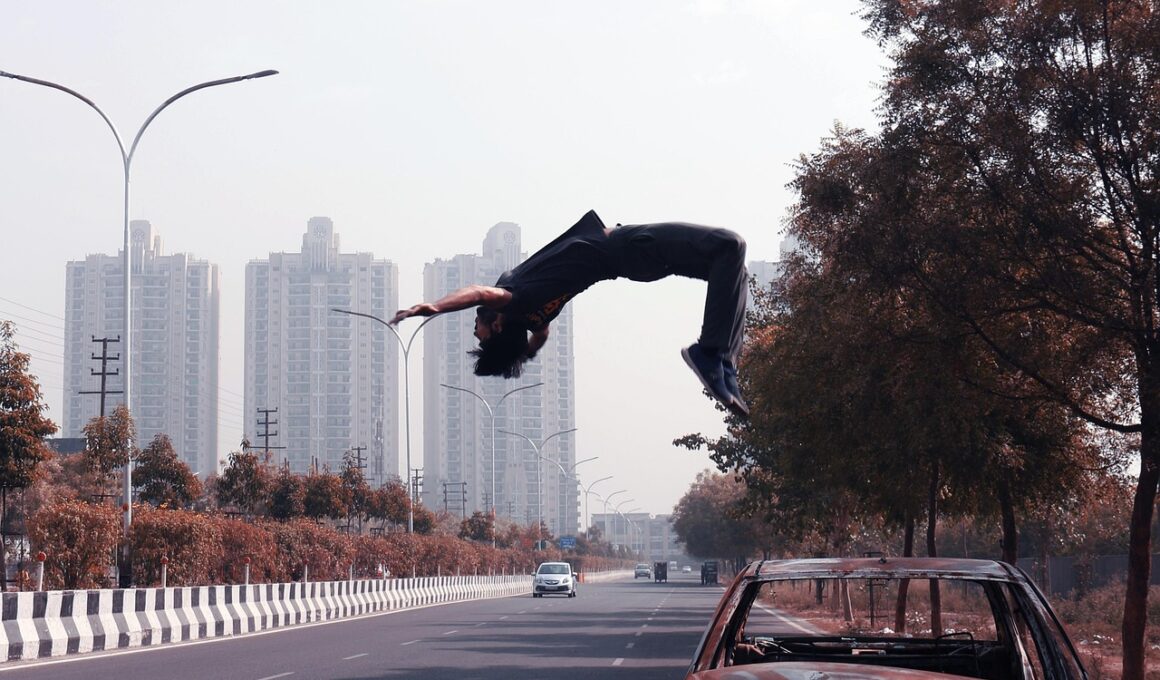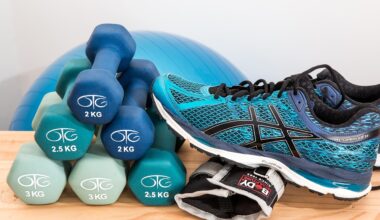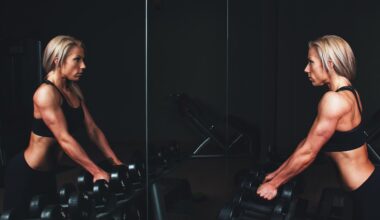The Role of Flexibility in Outdoor Parkour Training
Parkour is an exhilarating discipline that combines athleticism, creativity, and theoretical knowledge. While strength and agility are essential, flexibility also plays a crucial role in executing various movements. Flexibility can enhance performance by allowing for smoother transitions and reducing the risk of injuries. A well-prepared body can adapt to the demands of dynamic movements, thus enabling practitioners to take on diverse challenges within their environment. Developing flexibility should be approached through dedicated stretching routines that target the muscles involved in parkour. Adequate emphasis on both upper and lower body flexibility creates a more comprehensive level of readiness. Conducting flexibility exercises before and after training sessions will assist in improving overall mobility and body control. Incorporating hip openers, quad stretches, and spinal twists can assist in achieving a complete workout. By prioritizing flexibility, parkour enthusiasts can enhance their range of motion, optimize their performance, and ensure long-term success in the discipline. A flexible body gives practitioners the chance to be more creative and dynamic in their movement patterns, thus maximizing their potential for expression in this art form.
Many parkour practitioners engage in a variety of stretching techniques to increase their flexibility. Static stretching, dynamic stretching, and active stretching are several methods that can be incorporated into training routines. Each technique serves a different purpose and should be used in different contexts. Static stretching involves holding a stretch for a specific duration, usually longer than 15 seconds. This method is excellent for increasing flexibility over time but should be performed after workouts. Conversely, dynamic stretching uses movement to prepare the muscles for action before training. Performing leg swings, arm circles, or torso twists can elevate heart rates and activate the muscles effectively. Lastly, active stretching involves engaging muscles to stretch and is useful to maintain flexibility without external assistance. Educating yourself on these options is beneficial, allowing you to tailor your flexibility routine based on specific needs. For parkour, a combination of these techniques leads to a well-rounded approach to flexibility training. Not only does improving flexibility contribute to enhanced performance, but it also fosters a better understanding of one’s body mechanics during parkour routes.
Importance of Flexibility for Safety
In any sport, safety should always be a top priority, and parkour is no exception. A flexible body significantly decreases the risk of injuries during falls, jumps, and landings. Flexibility helps prevent muscle strains, tears, or discomfort that can result from sudden and unpredictable movements. The risk of overuse injuries is also diminished when the body is accustomed to a wide range of motion. An important aspect of parkour is landing technique, which flexibility can help refine. When transitioning into landings, having flexible joints allows for optimal shock absorption, thus minimizing the impact on the body. Flexibility enables practitioners to adapt and modify their movements depending on the circumstances. For beginners, developing flexibility can create a more confident approach to executing techniques, reducing fear and hesitation. A structured warm-up routine that emphasizes flexibility can warm up muscle fibers and increase blood flow, organically reducing the likelihood of immediate injuries. Additionally, understanding one’s current limitations can encourage conscious progression, allowing practitioners to build stronger and more resilient bodies over time.
Beyond physical safety, flexibility impacts mental aspects of parkour training. When practitioners understand their bodies’ range of motion, it fosters greater self-awareness and confidence in executing movements. Improved flexibility enables individuals to try more complex movements, empowering their creativity during training sessions. Parkour often requires practitioners to navigate various terrains and obstacles that demand mobility. When practitioners feel confident in their flexibility, they are more likely to engage with diverse environments actively and experiment with new maneuvers. This blend of mental and physical synergy is essential in advancing one’s skills in parkour. Moreover, incorporating flexibility training encourages a habit of mindfulness, as practitioners take the time to listen to their bodies. This awareness enables them to notice any tension or discomfort quickly and address it early on. By practicing mindfulness and flexibility, individuals cultivate a balanced relationship with their training routine, promoting overall well-being. Consequently, this holistic approach enhances both physical proficiency and mental resilience in the world of parkour, fulfilling the discipline’s artistic potential.
Incorporating Flexibility into Workouts
To develop a dedicated flexibility training regimen, practitioners should allocate specific timeframes within their weekly workout schedule. Integrating flexibility exercises into warm-ups, cooldowns, and dedicated training days is critical for development. It is beneficial to commit to at least three sessions weekly, focusing on both active and static exercises for efficiency. Allocating 10-15 minutes at the beginning and end of each training session for flexibility can yield significant improvements over time. Concentrating on major muscle groups utilized in parkour, such as the legs, hips, and spine, can result in a more effective routine. Popular flexibility exercises include hamstring stretches, pigeon poses, and shoulder openers. Online resources and tutorials can further guide practitioners in discovering new exercises, ensuring a diverse approach to flexibility. Consistency is key; those investing effort into their flexibility training will ultimately notice substantial gains in performance and agility. Remember, progress may vary; the focus should evolve around gradual improvements rather than immediate results. Listening to your body will aid in overcoming plateaus and facilitate ongoing development.
As parkour practitioners progress in their journey, goal-setting for flexibility is essential for continued improvement. Establishing short-term, achievable goals can create a tangible pathway to track progress over time. Goals may include successfully performing specific stretches or enhancing performance in challenging parkour techniques. Highlighting accomplishments, no matter how small, can provide motivation and encourage persistence in training routines. Keep a log of workouts and progress, documenting improvements in flexibility for reflection. This accountability aids in cultivating a regular training habit, as consistency is foundational to achieving desired results. Participating in group classes or training with others can help maintain motivation and introduce friendly competition, driving improvement rates. Watching others succeed can inspire new ideas for your flexibility training, making it more enjoyable. Additionally, seeking guidance from specialized coaches or flexible training experts can further augment your training journey. Their expertise can offer valuable insights into tailoring routines to better suit individual needs. Creating a supportive community fosters a shared passion for the discipline and strengthens bonds while evolving together in the world of parkour.
Conclusion: The Path to Flexibility
In conclusion, embracing flexibility training in outdoor parkour is vital for practitioners of all skill levels. Flexibility enhances performance, reduces injury risks, and builds mental resilience during training sessions. Understanding the importance of stretching techniques and their applications fosters a more thorough preparation approach. Additionally, setting achievable goals and maintaining accountability are crucial in developing a solid flexibility routine. The focus should be on gradual improvements and the enjoyment of the journey in parkour training. Always listen to your body and adopt a balanced approach between performance and safety to experience growth in the physical and mental realms. With a commitment to enhancing flexibility, parkour enthusiasts will unlock new possibilities within their craft. Ultimately, flexibility serves as a cornerstone in mastering the art of parkour. Prioritize this aspect of training to create a fulfilling experience and hone your skills in outdoor settings. Remember, flexibility not only aids in physical prowess but also cultivates a deeper connection to movement and expression, fostering a vibrant parkour lifestyle.
Practicing flexibility should never feel like a burden; instead, consider it an essential and enjoyable part of parkour training. Turning your flexibility routine into a creative process can only deepen your engagement with the art form. Set up a series of movements that challenge and inspire you to push past your limits, creatively merging fluidity and strength. Always remember that each person’s journey is unique; comparing your flexibility progression to others can deter motivation and joy. Focus on personal goals, celebrate the journey, and connect with fellow enthusiasts to share experiences and ideas. Participate in workshops or group practices to learn new strategies and foster camaraderie within the parkour community. Establishing connections through a mutual love for the discipline will further enrich your practice. Also, consider capturing your progress through video or journals, as this reflection can spark encouraging moments and insights throughout your training journey. Flexibility will not only evolve your physical capabilities but also enhance your artistic expression within parkour. Engage with flexibility daily, and embrace the adventure that lies ahead in expanding your parkour journey.


